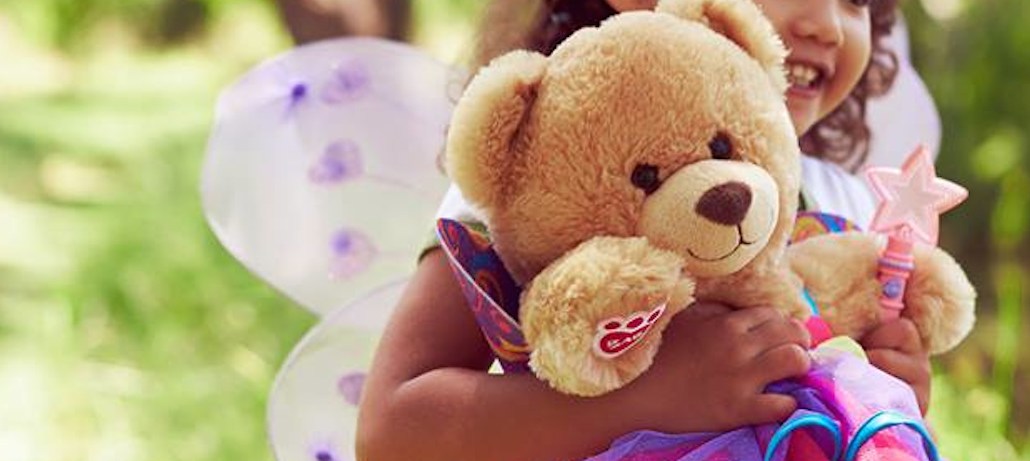Register by Jan 13 to save on passes and connect with marketers from Uber, Bose and more

This is ThinkTank, a series in which we quiz brand chiefs and CMOs on where the industry is heading.
Today’s screen-entranced kids might be more likely to sleep with an iPad under their arms than they are a teddy bear. That’s bad news for Build-A-Bear Workshop, the stuff-your-own-animal store founded by the former Payless ShoeSource president in 1997.
Company sales began to slip in 2013, when the company posted a six-month profit loss. Build-A-Bear CEO Sharon Price John pushed the company back into profitability, and a revamped focus on “beyond the plush” — a move to build a digital, interactive online experience to complement the in-store — is a key company strategy in staying relevant. In its Q1 earnings call, the company reported a two percent year-over-year comparable sales increase and net retail sales of $91.6 million.
We spoke to Build-A-Bear Workshop’s CMO Gina Collins, who joined the team in 2014 (Collins most recently served as Coca-Cola’s vp of entertainment marketing), about where a brick-and-mortar company should draw the line on digital. The interview has been condensed and lightly edited for clarity.
Such a huge part of the Build-A-Bear experience happens offline. How do you keep people coming to stores?
It circles back to the whole conversation around why is mall traffic down: visits to Build-A-Bear are planned, so we’re bringing traffic to shopping malls. Other retailers are dependent on who’s trafficking the mall. We also have a pop-up strategy — we’ve had an amazing relationship with Macy’s over the holidays — that hones in on what makes sense for the consumer.
What we’ve found is that people are crunched for time. Where experience makes sense for retail is when you’re trying to do a lot at once, but also create memories. Our experience doesn’t take all day, it’s emotionally driven, and it brings people in store.

Why don’t you let people Build-a-Bear online?
I think if we really wanted to, we could certainly create a version of the experience online, but we would never want to do that. It takes away that particular moment — you can spend time with your grandparents, your kids and get that face time and have a conversation about what you want out of this friend. It puts some fun in the day.
Build-A-Bear’s original YouTube series, Bearville Alive, broke site records. How did that happen?
We really wanted to tackle engaging content in a purposeful way, rather than from a marketing standpoint. In the end we went back to the notion of organic play. In the eyes of our consumers, a bear can be a firefighter or a doctor, so we took that premise and brought the animals to life in an interactive series. It was a test to see if that’s what consumers wanted to see and we were thrilled with the participation, comments and engagement we’ve been getting. [Build-A-Bear’s YouTube account has 23,000 subscribers; the Bearville Alive series has gotten more than 8 million total views since November 2014.]
Part of Build-A-Bear’s digital strategy is to bring its animals alive online, and the company recently replaced its virtual world, Bearville, with Build-A-Bear Play, a gaming center. Why the change?
Virtual worlds, years ago, served a purpose. When we considered transitioning to where we are now, we wanted to understand what that world brought to our consumer. It makes the life of their friends more real. So we evolved to change that virtual world and broaden into more applications rather than just layering on top of this one world.
How has it gone?
We made sure we were optimized for mobile, so customers could engage on their phones as much as they wanted to. [After the relaunch,] we saw a 200 percent increase in mobile activity, which we took to mean it was working, especially among millennial parents, whose kids are second-generation Build-A-Bear customers.
More in Marketing

Retail leaders at Target, Lowe’s and more on the AI investments they’re plotting for 2026
Anywhere from 33% to 83% of respondents used AI to do their holiday shopping in 2025.

Why cookware brand HexClad is sitting out of the Super Bowl for a broader field
With Super Bowl ad costs hitting $8 million, brands like HexClad are pivoting to streaming and other sports stages for a better marketing bet.

Inside the brand and agency scramble for first-party data in the AI era
Brands are moving faster to own first-party data as AI and privacy changes alter the digital advertising landscape.





